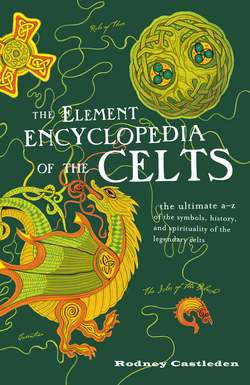Читать книгу The Element Encyclopedia of the Celts - Rodney Castleden - Страница 9
BARBARIANS?
ОглавлениеThe earliest documented reference to the Celts comes from about 450 BC. Herodotus, long known as “the father of history,” mentions the “Keltoi” briefly:
The River Ister [Danube] begins in the country of the Celts and the city of Pyrene [perhaps Girona, near Barcelona] and flows through the middle of Europe, bisecting it. The Celts are outside the Pillars of Heracles, bordering the Kynesians, who dwell at the edge, farther toward the setting sun than all other inhabitants of Europe.
Herodotus was well traveled, but he admitted to knowing little about northern and western Europe. His Celts are located in relation to the source of the Danube, which he wrongly believed to be near the Pyrenees, but he emphasized that the Celts lived further west in Europe than any other race. This implies that he was thinking of them as being the people of the Atlantic fringe, not of central Europe, but the misplacing of the Danube source confuses the issue. Herodotus had perhaps heard that the Kynesians and Keltoi lived in the far west (the Bay of Biscay coast of northern Spain), not far from the Pyrenees, and that was true. It was also true that those people lived further west than the Pillars of Heracles, which were the Straits of Gibraltar (longitude 5° 21’W). The longitude of La Coruña in Galicia is 8° 25’W, three degrees further west. Herodotus was just mistaken about the course of the Danube. Nineteenthcentury scholars chose to correct him regarding the river’s source, which is in the Black Forest, and accordingly moved the homeland of the Celts to southern Germany as well.
Other fragmentary references to the Keltoi suggest that some Greeks may have used the name loosely to apply to all the tribes of northern and western Europe.
The ancient Greeks thought their own language was the hallmark of civilization and that people who gabbled away in foreign languages were automatically uncivilized—the meaningless “barbar” of their speech defined them as barbarians. So the Greeks tended to lump together all the indigenous peoples of northern, central, and western Europe—non-Mediterranean Europe—and treat them as if they were all the same, even though they were not.
By the fourth century BC, the Celts were regarded as one of the four peripheral peoples of the known world. To the south were the Ethiopians, to the east were the Scythians, and a long way farther off were the Indians. It was a simple, generalized view: only the Mediterranean world was in sharp focus.
The Roman writers of 2,000 years ago took the same view as their Greek predecessors, regarding all the non-Latin-speaking peoples who lived to the north as “barbarians.” The word was not used with any anthropological accuracy—even then—and covered a multitude of peoples with a range of customs and traditions. Roman writers had little interest in the ethnic differences among these peoples. The word Galli was used in the same negative way as the label “barbarian”—the Galli, Gauls, or Celts were all the uncivilized people on the other side of the Alps, and the Romans were doing them a tremendous favor by conquering and civilizing them.
The Romans stereotyped these people, denigrating them in standard clichés. The Celts wore trousers (a very primitive garment compared with Roman tunics and togas) and let their hair grow long and tousled. They were tattooed, foolhardy, and aggressive. They were childish, quarrelsome, and inconstant. They went in for bloodthirsty rituals including human sacrifice. They were headhunters and drunkards, and led scandalous sex lives. In Britain, most amazingly of all, their warriors tore about in chariots—an outmoded style of warfare that in the Mediterranean world had gone out with Homer’s Iliad. (The Romans used chariots only for racing and for sport, not for warfare.)
The Romans liked to portray the Celts as backward and primitive. When Roman legionaries were posted along Hadrian’s Wall, they referred disparagingly to the native Celts as Brittunculi—“wretched little Brits.” It was typical colonial army talk.
The mindset of the Romans was not so very different than that of the British imperialists who 1,700 years later denigrated a wide range of native peoples all around the world, labeling them “pagans,” “heathens,” or even “cannibals.” Bringing such unfortunates under the umbrella of British rule and converting them to Christianity was seen as the right thing to do. The British genuinely believed they were doing these modern barbarians a favor by conquering them, imposing British law, and forcing on them a Victorian version of Christianity.
Having said this, the Roman commentators were partially right, at least in grouping together the peoples who lived north of the Alps. In the period 500–200 BC, north of the Alps from France across Europe to the Black Sea, there was a family of peoples who shared a number of common elements.
A surge in population growth seems to have driven the central European group to become expansionist. In about 400 BC, Celtic tribes moved south into Italy. In 387 BC, they defeated the Romans in battle and sacked Rome itself. In 279 BC, another group of Celts moved into Greece, attacking and plundering the rich, sacred site of Delphi. The following year, 278 BC, three tribes crossed into Asia Minor. Together these three tribes were known as the Galatae, which may be the ultimate origin of the name Keltoi (in Greek) or Celtae (in Latin). They established colonies in what is still known as Galatia.
These things happened. But nineteenth-century historians believed that there was an aggressive expansion in all directions.
